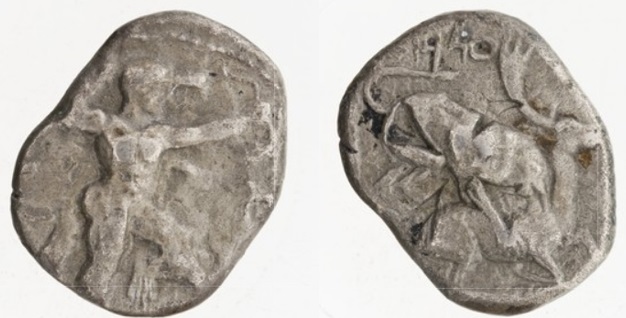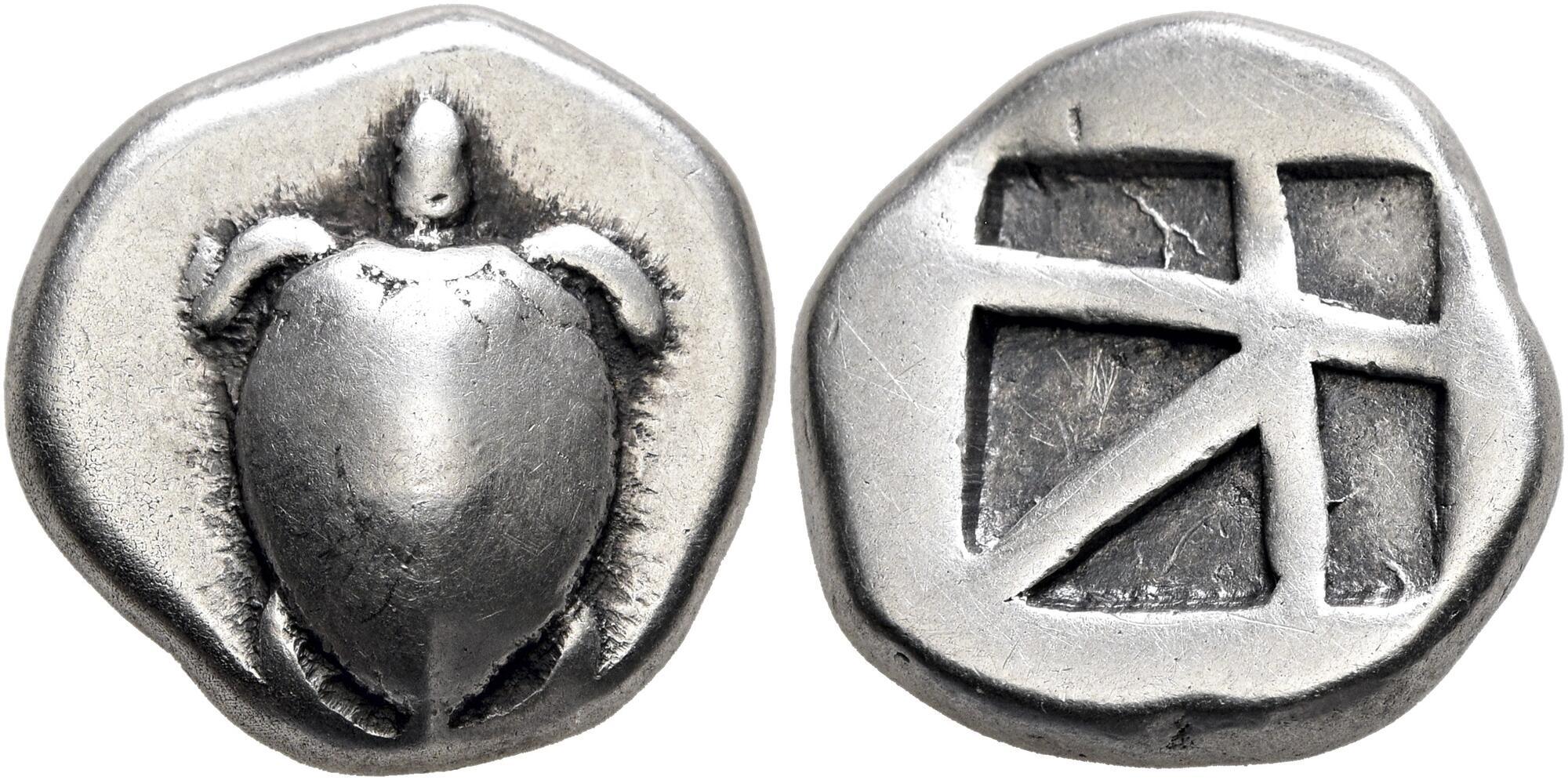1698 - Citium (Baalmelek) (double siglos Heracles/lion & stag) over Aegina (turtle/incuse square) (New York, ANS, 1951.116.81): Difference between revisions
From SILVER
No edit summary |
No edit summary |
||
| Line 33: | Line 33: | ||
|Overstruck standard=Aeginetic | |Overstruck standard=Aeginetic | ||
|Coin series reference overstruck=HGC 6, n° 437 ; Meadows (forthcoming), Groups IIa-IIb | |Coin series reference overstruck=HGC 6, n° 437 ; Meadows (forthcoming), Groups IIa-IIb | ||
|Frequency of overstrikes=frequent | |Frequency of overstrikes=frequent | ||
|Level of confidence=sure | |Level of confidence=sure | ||
}} | }} | ||
Latest revision as of 07:37, 6 November 2023
425 BCE - 400 BCE | B'LMLK (in Aramaic)
Location/history
| Museum collectionMuseum collection: | New York, American Numismatic Society, 1951.116.81 | |
| Private collection(s)Private collection(s) ᵖ: | Gunther, C. Godfrey coll. |
Overstriking coin
Description
| ObverseInscription or printing placed on the obverse.: | Herakles in fighting stance to right, wearing lion skin upon his back and tied around neck, holding club overhead in right hand and bow extended before him in left hand. | ReverseInscription or printing placed on the reverse.: | B'LMLK (in Aramaic) (Aramaic) Lion attacking stag crouching right within incuse square. |
Mint and issuing power
| MintIdentifies the place of manufacture or issue of a numismatic object.: | Citium | Ancient regionAncient region. | Cyprus | Modern countryModern country: Greece | AuthorityIdentifies the issuing power. The authority can be "pretended" when the name or the portrait of X is on the coin but he/she was not the issuing power. It can also be "uncertain" when there is no mention of X on the coin but he/she was the issuing power according to the historical sources: | Baalmelek II of Citium (king of Citium and Idalium, 5th c. BC) |
Chronology
| FromIdentifies the initial date in a range assigned in a numismatic context. 425 BCE toIdentifies the final date in a range assigned in a numismatic context.. 400 BCE | Classical 480-323 BC |
Physical description
| MetalThe physical material (usually metal) from which an object is made.: Silver |
WeightWeight of the numismatic object (in grams). in grams: 10.6610.66 g <br />10,660 mg <br /> | DenominationTerm indicating the value of a numismatic object. Examples: tetradrachm, chalkous, denarius.: double siglos |
AxisDescribes the directional relationship between the obverse and reverse of a numismatic object.: 66 mm <br />0.6 cm <br /> |
| StandardStandard.: Persian | |||
References
| Coin referenceReference of the Coin: | Destrooper-Georgiades 2013, p. 22, n° 41 | Coin series referenceReference to coin series study: | BMC Crete1BMC Crete, n° 35, Zapiti - Michaelidou 20082Zapiti - Michaelidou 2008, n° 5–8, Destrooper-Georgiades 20133Destrooper-Georgiades 2013, p. 22, n° 41 |
Overstruck type
Description
| ObverseInscription or printing placed on the obverse.: | Turtle (visible on the coin's obverse). | ReverseInscription or printing placed on the reverse.: | Incuse square (visible on the coin's reverse : mill-sail reverse pattern). |
Mint and issuing power
| MintIdentifies the place of manufacture or issue of a numismatic object. ᵖ: | Aegina | Ancient regionAncient region. ᵖ | Attica | Modern countryModern country: Greece | AuthorityIdentifies the authority in whose name (explicitly or implicitly) a numismatic object was issued. ᵖ: |
Chronology
| FromIdentifies the initial date in a range assigned in a numismatic context. 480 BCE toIdentifies the final date in a range assigned in a numismatic context.. 457 BCE | Classical 480-323 BC |
Physical description
| DenominationTerm indicating the value of a numismatic object. Examples: tetradrachm, chalkous, denarius. ᵖ: | stater |
StandardStandard. ᵖ: | Aeginetic |
References
| Coin type referenceReference to coin series study ᵖ: | HGC 64HGC 6, n° 437, Meadows (forthcoming)5Meadows (forthcoming), Groups IIa-IIb |
Additional data
| Frequency of overstrikesFrequency of overstrikes: | frequent | Level of confidenceLevel of confidence of the identification: | sure |
| RemarksRemarks: | |||

